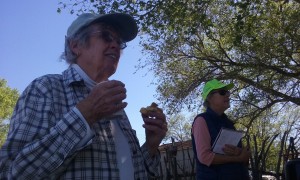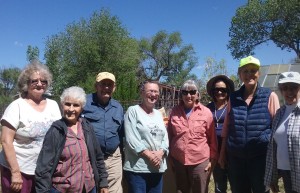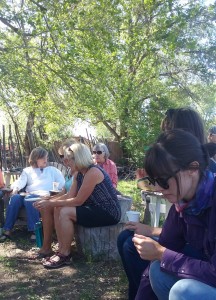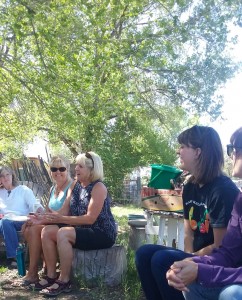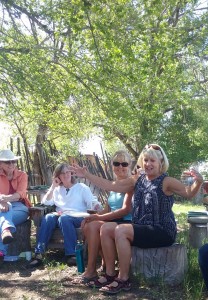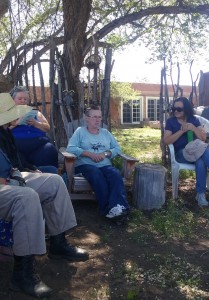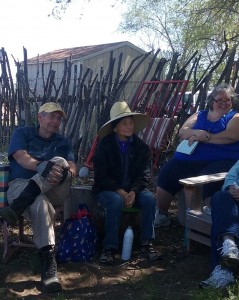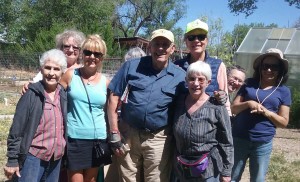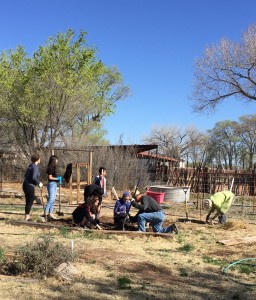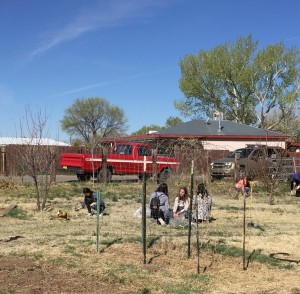Regenerative, Organic Agriculture Is Essential to Fighting Climate Change
“Regenerative agriculture” refers to farming and grazing practices that, among other benefits, reverse climate change by rebuilding soil organic matter and restoring degraded soil biodiversity. This results in both carbon drawdown and improved water infiltration and storage in soils.
Regenerative practices include:
• Reduction or elimination of tillage and the use of synthetic chemicals
• Use of cover crops, crop rotations, compost and animal manures
• Integrating animals with perennial and annual plants to create a biologically diverse ecosystem on the farm
• Grazing and pasturing animals on grass, and more specifically using a planned multi-paddock rotation system
• Raising animals in conditions that mimic their natural habitat
See the full article by Ronnie Cummins here:
This collector-grower built an Eden of rare plants.
I worry about invasive plants from outside the native growing area, but I have to admire this couple’s dedication.
Detroit hives in vacant lots
17 best patty pan recipes
Surely you’ll find something to like here.
https://www.countryliving.com/food-drinks/g4691/patty-pan-squash/
Fried Okra recipe
Okra cooked in the oven like this are a revelation. The first time I did it, I planned on having them as a side with dinner, but I ate every single piece before we sat down and concluded they were more appropriate as a snack. In the spirit of kale chips, but way tastier and more substantial, these fries will cook unevenly, so expect some crispy spots mingled with more chewy bites. If you’re using large, fat okra, slice them into quarters. If you’ve got immature pods, split them in half.Ingredients
Serves 4
1 pound okra (453 g; 20–25 pods), split or quartered lengthwise
2 tablespoons extra-virgin olive oil
2 teaspoons ground coriander
1 teaspoon salt 10 turns of the pepper mill or ¼ teaspoon black pepper
Procedure
- Preheat the oven to 400°F (200°C).
- In a medium bowl, toss the okra with the olive oil, coriander, salt, and black pepper.
- Spread the okra onto a large baking pan, or two pans if necessary. What’s important is that the okra have plenty of room to spread out. If they are all piled on top of one another, they will steam, not roast.
- Slide the pan onto the middle rack of the preheated oven.
- After 10 minutes, toss the okra gently with a spatula and rotate the pans if you are using two.
- Cook an additional 10 to 15 minutes. When the okra is done, it will be brown and crispy in a lot of places but shouldn’t smell burnt.
- Serve warm or at room temperature as a snack.
Cover Crops for Soil Health
Some good ideas here but may take awhile to load the 64 pages.
“Learn the principles, of which there are few, and you can develop the practices for yourself, and when conditions change, you know how to change the practices.”
These principles are:
- Minimize soil disturbance
- Keep the soil covered
- Keep a living root in the soil as much as possible
- Provide diversity
- Integrate livestock
https://www.greencoverseed.com/wordpress/wp-content/uploads/2019/04/Soil-Health-Resource-Guide.pdf
Click to view table of contents: Soil Health Cover Crops contents
Want to know how climate change will affect crops in some specific states?
Although New Mexico isn’t listed, many states are, and their experience could be relevant to ours. Check out this article:
From Apples to Popcorn, Climate Change Is Altering the Foods America Grows
https://www.nytimes.com/2019/04/30/dining/farming-climate-change.htm
Note that raspberries, tart cherries, watermelons, chickpeas, wild blueberries, heirloom popcorn, peaches, apples, kiwi fruit, artichokes, and rice are at risk.
Our May Day membership meeting and brunch
Image
You would have had to be there to hear each member’s reason for being there. I didn’t hear anybody say we don’t use pesticides or herbicides, and our only fertilizers are manure and compost. Maybe by now it goes without saying. Joyce told about the bio-reactor workshop she and Ron attended and our plans to make one. You can learn what it is and how to build one at the following link. Go to page 8 to see what it looks like. What amazes me the most are the air tunnels and the one-minute-a-day watering- on-a-timer routine.
http://case.nmsu.edu/case/pasodelnorteagriculturalworkshops/documents/Johnson-Su_Bioreactor_BMP.pdf
Last week we gave away a worm farm at the Whitfield Science Fair, and today some of us remembered Dave whose story and video about eliminating trash for a year are here:
Meet Dave, the Man Who Never Takes Out the Trash
and here:
Grain School in July
Go to GRAIN SCHOOL at the Albuquerque Museum in Albuquerque, New Mexico!
July 26 – 27, 2019
Albuquerque, NM
Presented by the Rocky Mountain Seed Alliance in partnership with Seed Broadcast and Garden’s Edge.
With a focus on ancient and heritage grains, you will learn expert techniques and hands-on skills to grow, harvest, mill, market, and bake with locally adapted grains. Nutritional values of ancient grains will be presented, along with the ecological benefits of adding grains to your garden or farm portfolio.
The course will include field studies at Albuquerque’s Garden’s Edge Grain Garden.
Regular price: $200 – Includes a locally sourced lunch with heritage grains featured
RMSA Supporting Members price: $160
https://rockymountainseeds.org/attend/grain-school/grain-school-albuquerque
Using Mushroom bricks to remediate soil

Oyster mushrooms may break down contaminants in Northern New Mexico.
 t the Española Healing Foods Oasis in Española, New Mexico, Pueblo dryland farming techniques are on display in a downtown public park. The garden, designed and planted by the Indigenous-led organization Tewa Women United, demonstrates how food and medicine can be grown in an environment that receives just 11 inches of rain per year. And at a nearby community garden, which the organization helped operate in the past, Pueblo members and locals grow fruit and vegetables.
t the Española Healing Foods Oasis in Española, New Mexico, Pueblo dryland farming techniques are on display in a downtown public park. The garden, designed and planted by the Indigenous-led organization Tewa Women United, demonstrates how food and medicine can be grown in an environment that receives just 11 inches of rain per year. And at a nearby community garden, which the organization helped operate in the past, Pueblo members and locals grow fruit and vegetables.
The garden projects are part of the organization’s efforts to grow foods and herbs for people in the Eight Northern Indian Pueblos, as well as locals in the wider Española Valley, using traditional methods. But there’s a problem: The soils at these gardens are being exposed to contaminants. Tewa Women United hopes oyster mushrooms will clean them up.
Check out Tewa Women United’s Facebook page here:
https://www.facebook.com/TewaWomenUnited/
Valencia Community Gardens May 1, 2019 Annual Membership Meeting
Valencia Community Gardens’ annual membership meeting will be held Wed. May 1st at 10 am at the Garden on Silva Rd. in historic Tome. This year marks our 10th Anniversary, and we will share how the garden developed, our current activities, and our plans for the future. New members are welcome. Come enjoy the fellowship of other gardeners growing fresh healthy food. Coffee and pastries will be served. Call President Deb Christensen at 865-4070 for more info.
Sustainable Agriculture the only good choice
This UN report, published in 2013, is long and surfacing now for good reason.
https://unctad.org/en/PublicationsLibrary/ditcted2012d3_en.pdf
The report is summarized here:
UN REPORT SAYS SMALL-SCALE ORGANIC FARMING ONLY WAY TO FEED THE WORLD
http://www.technologywater.com/post/69995394390/un-report-says-small-scale-organic-farming-only
Lots of helpers at the garden
Another picture of the whole group at our facebook page: https://www.facebook.com/Valencia-Community-Gardens-529928913724097
35 youth volunteers, led by Athena Pratt and other dedicated adults, gave the garden a big boost yesterday when they came to dig out bermuda grass and perform other much-needed garden cultivating. As Joyce Johns, our outreach person and former president said, “The event was well focused, adults and youth working together and learning, similar to our own way of working in the garden. It was a good match.” From near and far–from Bosque Farms, Albuquerque, and Carrizozzo to Costa Rica–the helpers were respectful to us and the garden and really seemed to enjoy the work. VCG President Deb Christensen adds, “It WAS a good day with the kids.” Thank you thank you. Joyce’s photos give a taste of the attentiveness, quiet energy and good spirit of the kids.
Outreach gardener Joyce Johns said “the event was well focused, adults and youth working together and learning, similar to our own way of working in the garden. It was a good match.”
To learn more about the volunteers’ belief in service, see https://www.bahai.org/beliefs/life-spirit/devotion/work-service
MAY 1, 2019 VCG Annual Membership Meeting
-
Wednesday, May 1, 2019 at 10 a.m.Agenda coming soon. Breakfast/brunch will be served.Where: Valencia Community Gardens on Silva Road just north of the Tomé GalleryJoin or renew your membership. We meet on Wednesday and Saturday mornings through the growing season.

